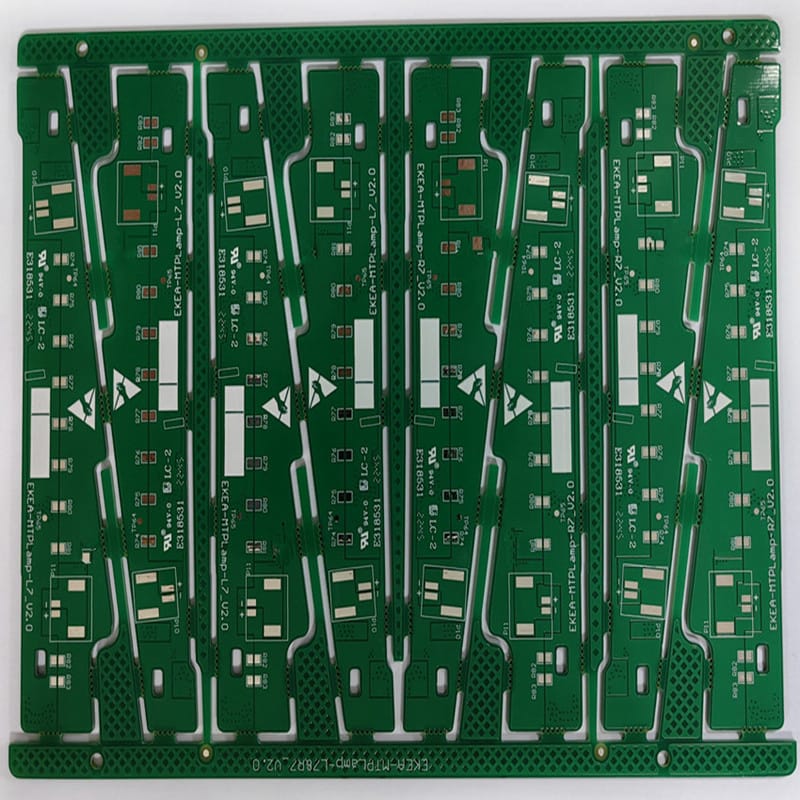Pcb processing prototype board 94v-0 Halogen-free circuit board
Product Specification:
| Base Material: | FR4 TG140 |
| PCB Thickness: | 1.6+/-10%mm |
| Layer Count: | 2L |
| Copper Thickness: | 1/1 oz |
| Surface treatment: | HASL-LF |
| Solder mask: | Glossy green |
| Silkscreen: | White |
| Special process : | Standard, Halogen-free circuit board |
Application
The fire rating of the printed circuit board refers to the fire rating of the board. Printed circuit boards are usually made of glass fiber material with a fire rating of FR-4. This material has a high fire rating and can prevent fires to a certain extent. Of course, according to factors such as application requirements and safety requirements, the fire rating of printed circuit boards can also adopt other different materials and standards.
The specific standard of UL94v0 is that the circuit board has reached the fire retardant standard. ul94 equipment and appliance components burning test of plastic materials, with standard name, scope of application, grade classification, related standards, etc. UL94 Plastic material combustion test - Classification:
1) HB level: Horizontal Burning Test
2) V0-V2 level: Vertical Burning Test Vertical burning test
The flame retardant grade of plastics increases from HB, V-2, V-1 to V-0 step by step:
UL 94 (Flammability test for plastic materials)
HB: The lowest flame retardant grade in UL94 standard. For samples 3 to 13 mm thick, burn at a rate of less than 40 mm per minute and for samples 3 mm thick, burn at a rate of less than 70 mm per minute or extinguish before the 100 mm mark.
V-2: Flame extinguished within 30 seconds after two 10-second combustion tests of the sample. It can ignite 30cm cotton.
V-1: Flame extinguished within 30 seconds after two 10-second combustion tests of the sample. Do not ignite 30cm cotton.
V-0: The flame is extinguished within 10 seconds after two 10-second combustion tests on the sample
According to the grade level from the bottom to the high division as follows: 94HB/94VO/22F/ CIM-1 / CIM-3 /FR-4, flame retardant characteristics of the grade division can be divided into 94V-0 /V-1 /V-2, 94-HB four kinds; 94HB: ordinary board, no fire (the lowest grade material, die punching, can not do power board) 94V0: flame retardant board (die punching) 22F: single-side half glass fiber board (die punching) CIM-1: single-side glass fiber board (must be computer drilling, can not die punching) CIM-3: Double sided half glass fiber board FR-4: double sided glass fiber board
Particular emphasis is all the boards of Shenzhen Lianchuang Electronics Co.,Ltd, fire rating meet 94v-0!
Halogen-free boards for printed circuit boards refer to halogen-free materials used in the manufacture of printed circuit boards. Halogen-free materials refer to materials that do not contain halogen elements such as chlorine and bromine. This material is more environmentally friendly and safer than traditional halogen-containing materials, and can reduce the harm to the environment and human body. In some countries and regions, the use of halogen-free materials to manufacture printed circuit boards has become a legal requirement or industry standard to promote sustainable development and environmental protection.
FAQs
The majority of PCBs are classified as FR-4, indicating that they meet certain performance criteria, as well as the V0 requirements of the UL (Underwriters Laboratories) 94 flammability testing standard.
UL 94 is used to measure burning rate and characteristics based on standard samples. Sample size is 12.7mm by 127mm, with the thickness varying from 0.8mm to 3.2mm.
A halogen free PCB is a printed circuit board with limited halogen elements. The main halogen elements that are fatal to life are chlorine, fluorine, bromine, astatine, and iodine. A halogen free PCB has less than 900 ppm of bromine or chlorine. Also, the board has less than 1500 ppm of halogen materials.
What's more, halogens degrade air quality by promoting surface ozone formation. At ground-level, ozone is a pollutant (& greenhouse gas) and prolonged exposure can lead to respiratory ailments, including asthma, and is damaging to crops.
Alkali metals and halogens do not occur free in nature because they are very reactive. They occur in a combined state.








